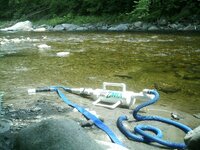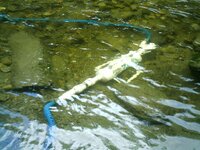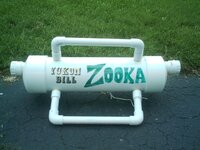Sluicedog
Jr. Member
- Jul 5, 2007
- 78
- 45
- Detector(s) used
- Whites GMT, Garrett Gold Stinger, Garrett XL500 Pulse, 2" Sub-Dredge,Goldsnare SGS-1, ELF detector, MFD w/electronic detector
- Primary Interest:
- Prospecting
I had fun for a week on the Ammonoosuc River. There was a Huge flood there on the 4th and the river campground area had to be evacuated total. On this past Monday 17th we had a mini 4 foot food that also churned up the river. All week long people where getting very little color. I used my SGS-1 Goldsnare with a 100 A/hour battery. Easy set up..carry down to river edge, place battery on dry bank, SGS-1 in the water, connect the battery clips and turn on the switch for the adventure!. The SGS-1 is very persistent in its processing and classification.
I tried a clay layer near shore on the high water day, did a 9 sq foot area (2-3") of float material (6 hours) at the waters edge and did a side bore into packed material in a 3 foot deep big boy dredge hole. This actually was not the best take of any trip to the Ammonoosuc River. Most of our group using high banker dredge combos were skunked too. My low banker did poor too. The SGS-1 worked great with ample black sand and garnets and pyrite collected.
I have a gas powered 2" sub-dredge and it did poorly with the take...got to try a different river!
Here are some pics. My green pan is total SGS-1 take for the week. The river had never been the same since Irene storm (August 2011). I got a little finger pinch between a melon sized rock and a hard place...not broken ..but great colors!
I tried a clay layer near shore on the high water day, did a 9 sq foot area (2-3") of float material (6 hours) at the waters edge and did a side bore into packed material in a 3 foot deep big boy dredge hole. This actually was not the best take of any trip to the Ammonoosuc River. Most of our group using high banker dredge combos were skunked too. My low banker did poor too. The SGS-1 worked great with ample black sand and garnets and pyrite collected.
I have a gas powered 2" sub-dredge and it did poorly with the take...got to try a different river!
Here are some pics. My green pan is total SGS-1 take for the week. The river had never been the same since Irene storm (August 2011). I got a little finger pinch between a melon sized rock and a hard place...not broken ..but great colors!









